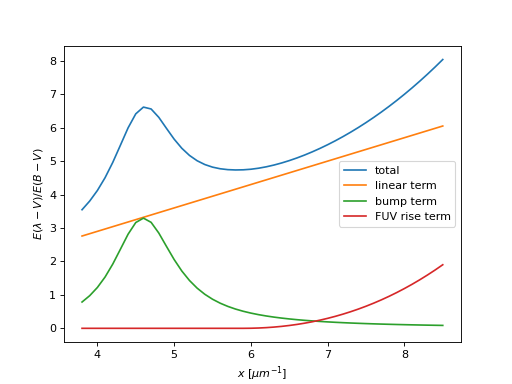FM90¶
- class dust_extinction.shapes.FM90(C1=0.1, C2=0.7, C3=3.23, C4=0.41, xo=4.6, gamma=0.99, **kwargs)[source]¶
Bases:
Fittable1DModelFitzpatrick & Massa (1990) 6 parameter ultraviolet shape model
- Parameters:
- C1: float
y-intercept of linear term
- C2: float
slope of liner term
- C3: float
strength of “2175 A” bump (true amplitude is C3/gamma^2)
- C4: float
amplitude of FUV rise
- xo: float
centroid of “2175 A” bump
- gamma: float
width of “2175 A” bump
Notes
From Fitzpatrick & Massa (1990, ApJS, 72, 163)
Only applicable at UV wavelengths
Example showing a FM90 curve with components identified.
import numpy as np import matplotlib.pyplot as plt import astropy.units as u from dust_extinction.shapes import FM90 fig, ax = plt.subplots() # generate the curves and plot them x = np.arange(3.8,8.6,0.1)/u.micron ext_model = FM90() ax.plot(x,ext_model(x),label='total') ext_model = FM90(C3=0.0, C4=0.0) ax.plot(x,ext_model(x),label='linear term') ext_model = FM90(C1=0.0, C2=0.0, C4=0.0) ax.plot(x,ext_model(x),label='bump term') ext_model = FM90(C1=0.0, C2=0.0, C3=0.0) ax.plot(x,ext_model(x),label='FUV rise term') ax.set_xlabel(r'$x$ [$\mu m^{-1}$]') ax.set_ylabel(r'$E(\lambda - V)/E(B - V)$') ax.legend(loc='best') plt.show()
(
Source code,png,hires.png,pdf)
Attributes Summary
The number of inputs.
The number of outputs.
Names of the parameters that describe models of this type.
Methods Summary
__call__(*inputs[, model_set_axis, ...])Evaluate this model using the given input(s) and the parameter values that were specified when the model was instantiated.
evaluate(in_x, C1, C2, C3, C4, xo, gamma)FM90 function
fit_deriv(in_x, C1, C2, C3, C4, xo, gamma)Derivatives of the FM90 function with respect to the parameters
Attributes Documentation
- C1 = Parameter('C1', value=0.1)¶
- C2 = Parameter('C2', value=0.7)¶
- C3 = Parameter('C3', value=3.23)¶
- C4 = Parameter('C4', value=0.41)¶
- gamma = Parameter('gamma', value=0.99, bounds=(0.0, None))¶
- n_inputs = 1¶
The number of inputs.
- n_outputs = 1¶
The number of outputs.
- param_names = ('C1', 'C2', 'C3', 'C4', 'xo', 'gamma')¶
Names of the parameters that describe models of this type.
The parameters in this tuple are in the same order they should be passed in when initializing a model of a specific type. Some types of models, such as polynomial models, have a different number of parameters depending on some other property of the model, such as the degree.
When defining a custom model class the value of this attribute is automatically set by the
Parameterattributes defined in the class body.
- x_range = [2.857142857142857, 11.11111111111111]¶
- xo = Parameter('xo', value=4.6, bounds=(0.0, None))¶
Methods Documentation
- __call__(*inputs, model_set_axis=None, with_bounding_box=False, fill_value=nan, equivalencies=None, inputs_map=None, **new_inputs)¶
Evaluate this model using the given input(s) and the parameter values that were specified when the model was instantiated.
- static evaluate(in_x, C1, C2, C3, C4, xo, gamma)[source]¶
FM90 function
- Parameters:
- in_x: float
expects either x in units of wavelengths or frequency or assumes wavelengths in wavenumbers [1/micron]
internally wavenumbers are used
- Returns:
- exvebv: np array (float)
E(x-V)/E(B-V) extinction curve [mag]
- Raises:
- ValueError
Input x values outside of defined range